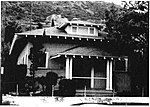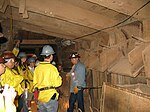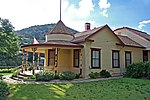Bisbee, Arizona
1880 establishments in Arizona TerritoryArtist coloniesBisbee, ArizonaCities in ArizonaCities in Cochise County, Arizona ... and 9 more
Cochise County conflictCompany towns in ArizonaCounty seats in ArizonaGeological type localitiesIndustrial Workers of the World in ArizonaMining communities in ArizonaPopulated places established in 1880Use American English from May 2021Use mdy dates from May 2021

Bisbee is a city in and the county seat of Cochise County in southeastern Arizona, United States. It is 92 miles (148 km) southeast of Tucson and 11 miles (18 km) north of the Mexican border. According to the 2020 census, the population of the town was 4,923, down from 5,575 in the 2010 census.
Excerpt from the Wikipedia article Bisbee, Arizona (License: CC BY-SA 3.0, Authors, Images).Bisbee, Arizona
Tombstone Canyon Road,
Geographical coordinates (GPS) Address Nearby Places Show on map
Geographical coordinates (GPS)
| Latitude | Longitude |
|---|---|
| N 31.448055555556 ° | E -109.92833333333 ° |
Address
Tombstone Canyon Road 668
85603
Arizona, United States
Open on Google Maps









